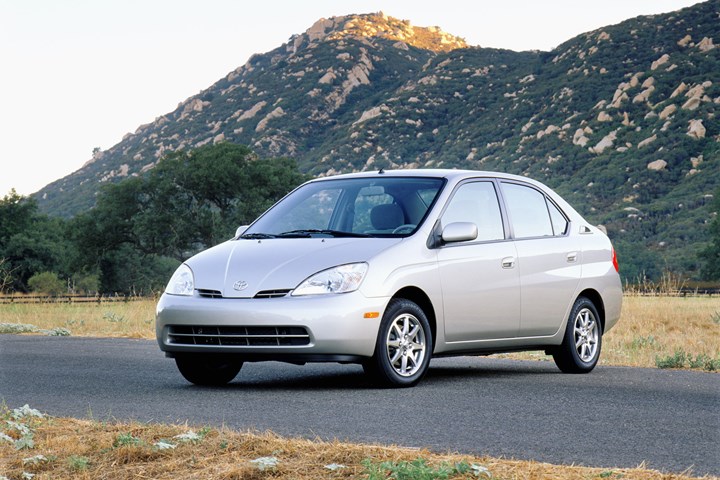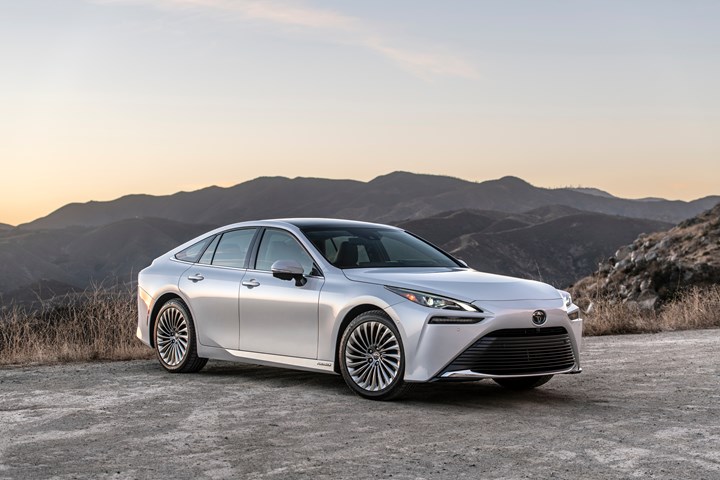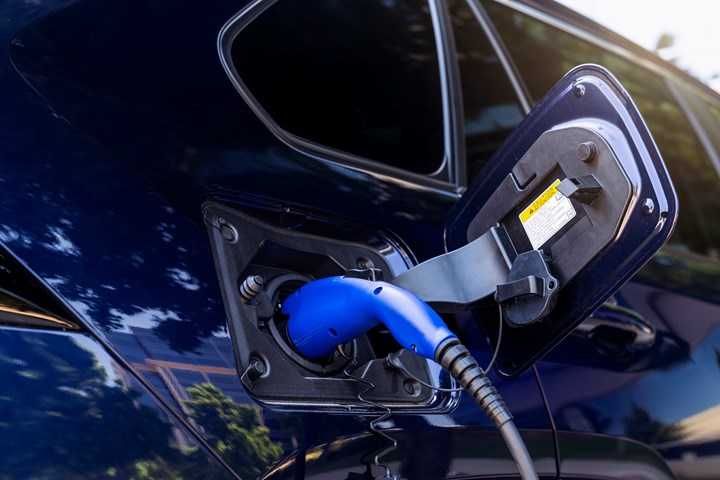Special Report: Toyota & Issues Electric
Although Toyota’s focus on hybrid powertrains at the seeming expense of the development of a portfolio of full battery electric vehicles (BEVs) for the market could cause some concern among those of an environmental orientation, in that Toyota doesn’t seem to be sufficiently supportive of the environment, in their estimation. Here’s something that could cause a reconsideration of that point of view.
#electronics
Hybrids & the Environment

First-generation Toyota Prius (2001). (All images: Toyota)
Cooper Erickson, group vice president, Product Planning and Strategy, Toyota Motor North America, makes a comparison between the environmental effects of battery electric vehicles (BEVs) and hybrids.
Hybrids have batteries, too. Not as large as those of BEVs. But batteries that are used for propulsion systems just the same.
Erickson says there needs to be a consideration of available resources. “When it comes to batteries,” he notes, “they use a lot of resources.”
(Resources like nickel, cobalt and other difficult-to-obtain, physically or politically.)
Consider, Erickson says, the two types of vehicles—BEVs and hybrids—in the context of resource utilization and the environmental consequences of each.
Some Math
Erickson says that Toyota has sold some 18 million hybrids over the past 20 years.
Because BEVs have bigger batteries than hybrids, he says that the number of full BEV batteries that could be made with the materials used for those 18 million hybrids is 260,000.
The amount of greenhouse gases that weren’t produced over the past 20 years by those 18 million hybrid vehicles is on the order of 140-million tons.
Erickson says that the number of BEVs that would be necessary to achieve that 18-million-ton reduction is 5.5 million.
The Result
So by building hybrids, there has been a more positive environmental effect than could be achieved by using the same materials to produce BEV batteries.
Seems like Toyota has been a good environmental steward by making those hybrids.
Erickson: “We have been a pioneer in greenhouse gas reduction for the past two decades and we will be for the next 20.”
==
What It Plans to Do
Toyota isn’t anti-BEV. Not by a long shot. It is investing $13.5-billion in global battery development.
It projects that by 2030, its global sales will look like this:
- 8 million electrified vehicles
- 2 million zero emissions vehicles (BEVs and fuel-cell electric vehicles)
- 2 million ICE vehicles
In other words, 80% electrified (i.e., hybrids and BEVs).
In the near(er) term, by 2025 it plans to have 15 BEVs on the market.
(Note that it doesn’t anticipate the disappearance of internal combustion engines.
(But when you take into account the fact that presently, according to the International Energy Agency, electric vehicles account for about 4.6% of global sales, that equivalence between the zero emissions and ICE vehicles is something that needs to be paid attention to.)
==
The “Other” EV

The 2022 Mirai: hydrogen is transformed into electricity.
Vehicles with hydrogen fuel cells are electric vehicles. Rather than storing energy in a large battery, as is the case with battery electric vehicles (BEVs), there is hydrogen stored in tanks on board. That hydrogen is converted to electricity by a fuel cell stack in the vehicle.
So the distinction is that there are BEVs and fuel cell electric vehicles (FCEVs).
Toyota has been selling the Mirai, a FCEV, in the U.S. since the summer of 2015.
Gen Two
It is now offering the second-generation Mirai, a RWD midsize car that seats five. It has a solid polymer electrolyte fuel cell that transforms the compressed hydrogen gas that is held in three 10,000-psi carbon-fiber reinforced tanks into electricity that powers an AC synchronous electric motor that produces a maximum 134 kW, or 182 hp. It has a range of some 400 miles. To refill the tanks requires about five minutes.
It has a starting MSRP of $49,500. As an incentive, Toyota is providing up to $15,000 of hydrogen fuel.
The Real Deal
According to Matt McClory, senior principal engineer, Fuel Cell Vehicle Development, Toyota Technical Center, it is worthwhile noting that the technology of fuel cells is sufficiently robust that Toyota is selling the Mirais, not just leasing them.
While they continue to work on the technology, a key focus is on “reducing the cost of the systems and the manufacturing.”
Although the fuel cell stack assembly is something that is often focused on in terms of its expense, McClory says that it is important to address the overall system cost, the product and the process.
Presently, the number of fuel cells being produced is low by typical automotive standards. Through the third quarter of 2021, Toyota sold 2,268 Mirais in the U.S. market.
Data from the California Fuel Cell Partnership (and in the U.S., California is the epicenter of hydrogen-powered vehicles) shows cumulative sales of FCEVs in the U.S. from 2012 to Q3 2021 is 12,082 units.
McClory points out that “volume manufacturing doesn’t necessarily bring the cost out.”
So that’s why addressing the system matters.
(It is worth noting that Toyota is going to be ramping up its fuel cell production: in 2023 there will be a dedicated line in the Toyota Motor Manufacturing Kentucky complex in Georgetown for assembling integrated dual fuel cell modules for heavy-duty commercial vehicles. Each module can provide up to 160 kW of continuous power. It is part of a complete fuel cell kit. A complete kit includes a high-voltage battery, electric motors, transmission, and hydrogen storage. These additional elements are going to be sourced from suppliers. Toyota will be offering powertrain integration know-how to producers of heavy-duty trucks who will deploy the fuel cells.)
Partnering
McClory says that Toyota is partnering with companies in the fueling space—FirstElement Fuel, Iwatani, Air Liquide, and Shell—to help develop additional resources for drivers, be they drivers of Class 8 trucks or passenger vehicles like the Mirai.
Although California is where there is the greatest number of hydrogen fueling stations—47 stations are open now and 120 are under development—McClory says that there are developments in the Pacific Northwest, Colorado, Texas, and the Northeast.
One important aspect of the build-out of the infrastructure (let’s face it: unless there is readily available fuel, there will not be a growth in the number of FCEVs) is that hydrogen is being produced to supply the stations with renewable sources—in California more than 90% of the hydrogen being used for transportation is “green,” as biogas, wind and solar are used to produce the gas.
So FCEVs are exceedingly clean vehicles.
(In case you are wondering: Yes, the Mirai has that vaunted low-end torque that is characteristic of BEVs—because it is powered by an electric motor, just like BEVs are. But think about that five-minute Mirai refueling time and think about the amount of recharging that can be done with even the most superlative fast charger. . . .)
==
Right-Sizing Matters
Another consideration regarding materials used in batteries and what this means for consumers.
Erickson points out that OEMs are involved in “a race” to develop batteries for vehicles that have 300. . .400. . .500. . .miles of range.
“But that is not good for the environment or the customer-use case,” he says.
Bigger batteries require, of course, more materials.
Erickson is saying that a bigger battery, for an individual’s needs, may not be beneficial. Environmentally. Economically. Practically.
Range anxiety?
Erickson notes that 90% of BEV owners have more than one vehicle in the household.
Presumably if someone suddenly needs to travel a long distance and doesn’t want to stop there is another vehicle available to get the job done.
==
When Is “Alternative” Regular?

Yes, the RAV4 Prime is a plug-in hybrid. But no, you don’t need to plug it in to drive it.
There is a significant messaging and understanding problem associated with alternative powertrains—powertrains that have been available for long enough that one could argue there’s not a whole lot “alternative” about them.
So admits Mike Tripp, Toyota vice president of Vehicle Marketing and Communications.
According to a recent survey, 66% of people think a battery electric vehicle has a gasoline engine.
Notably, when
“Does a BEV Have a Gas Engine?”
was asked in a 2019 survey, the number of people answering “Yes” was. . .66%.
Then a question about hybrid vehicles:
“Do You Need to Plug in a Hybrid?”
Yes: 75%.
While there are plug-in hybrids (PHEVs) that offer limited all-electric range, note the question was about hybrids in general.
And it doesn’t get better when there is some specificity added to the question.
Tripp says that only 10% of consumers understand that it isn’t required for a PHEV to be charged before it can be driven.
Clearly, consumer education is lagging the technology advances.
==
“bZ” Means “Beyond Zero”

The bZ4X. Not Toyota’s first battery electric vehicle. But potentially its most important as it starts the roll out of BEVs.
And while it might seem as though I’ve buried the lede. . .
Toyota has “officially” revealed the awkwardly named “bZ4X,” a compact BEV SUV that will be available in the U.S. in mid-2022.
The vehicle is based on a new architecture specifically developed for BEVs by Toyota and Subaru, the “e-TNGA.”
It will be available in both front- and all-wheel drive setups.
The FWD version has an estimated range of up to 250 miles. It has a 71.4-kWh lithium-ion battery that has a non-conductive liquid coolant running through it to maintain the optimal battery temp. There is also monitoring of the voltage and current, along with the temperature, to help prevent overheating. The battery can be charged to 80% within an hour on DC fast-charging systems.
The FWD bZ4X has a 150-kW AC synchronous motor. The AWD version (the vehicle uses Subaru’s AWD tech) has a two 80-kW motors, one front and one rear, for a system output of 160 kW. (It has a slightly bigger battery than the FWD version: 72.8-kWh.)
One of the seasons that BEVs tend not to do particularly well in is winter—at least in places where it is seriously WINTER. So to help assure energy savings, the bZ4X features a heat pump for the HVAC system, seat and steering wheel heaters (applying heat to where a person interfaces with a vehicle is more efficient than heating the air) and a front-seat radiant foot-and-leg heater.
(Toyota is no stranger to producing electric crossovers: it produced two generations of RAV4 EVs, with the first running from 1997 to 2003 and the second being in production from 2012 to 2014. The second is particularly interesting because the 386 V lithium-ion battery pack was provided by. . .Tesla.)
RELATED CONTENT
-
On Zeekr, the Price of EVs, and Lighting Design
About Zeekr, failure, the price of EVs, lighting design, and the exceedingly attractive Karma
-
On Electric Pickups, Flying Taxis, and Auto Industry Transformation
Ford goes for vertical integration, DENSO and Honeywell take to the skies, how suppliers feel about their customers, how vehicle customers feel about shopping, and insights from a software exec
-
GAC, CATL Partner on Two Battery Ventures
Two new battery ventures are being formed in China by domestic carmaker Guangzhou Automobile Group Ltd. and battery giant Contemporary Amperex Technology Ltd.


.jpg;width=70;height=70;mode=crop)






